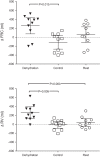Exercise-induced dehydration alters pulmonary function but does not modify airway responsiveness to dry air in athletes with mild asthma
- PMID: 28280109
- PMCID: PMC5451531
- DOI: 10.1152/japplphysiol.01114.2016
Exercise-induced dehydration alters pulmonary function but does not modify airway responsiveness to dry air in athletes with mild asthma
Abstract
Local airway water loss is the main physiological trigger for exercise-induced bronchoconstriction (EIB). Our aim was to investigate the effects of whole body water loss on airway responsiveness and pulmonary function in athletes with mild asthma and/or EIB. Ten recreational athletes with a medical diagnosis of mild asthma and/or EIB completed a randomized, crossover study. Pulmonary function tests, including spirometry, whole body plethysmography, and diffusing capacity of the lung for carbon monoxide (DlCO), were conducted before and after three conditions: 1) 2 h of exercise in the heat with no fluid intake (dehydration), 2) 2 h of exercise with ad libitum fluid intake (control), and 3) a time-matched rest period (rest). Airway responsiveness was assessed 2 h postexercise/rest via eucapnic voluntary hyperpnea (EVH) to dry air. Exercise in the heat with no fluid intake induced a state of mild dehydration, with a body mass loss of 2.3 ± 0.8% (SD). After EVH, airway narrowing was not different between conditions: median (interquartile range) maximum fall in forced expiratory volume in 1 s was 13 (7-15)%, 11 (9-24)%, and 12 (7-20)% in dehydration, control, and rest conditions, respectively. Dehydration caused a significant reduction in forced vital capacity (300 ± 190 ml, P = 0.001) and concomitant increases in residual volume (260 ± 180 ml, P = 0.001) and functional residual capacity (260 ± 250 ml, P = 0.011), with no change in DlCO Mild exercise-induced dehydration does not exaggerate airway responsiveness to dry air in athletes with mild asthma/EIB but may affect small airway function.NEW & NOTEWORTHY This study is the first to investigate the effect of whole body dehydration on airway responsiveness. Our data suggest that the airway response to dry air hyperpnea in athletes with mild asthma and/or exercise-induced bronchoconstriction is not exacerbated in a state of mild dehydration. On the basis of alterations in lung volumes, however, exercise-induced dehydration appears to compromise small airway function.
Keywords: airway hyperresponsiveness; eucapnic voluntary hyperpnea; exercise-induced asthma; exercise-induced bronchoconstriction; whole body dehydration.
Copyright © 2017 the American Physiological Society.
Figures





Similar articles
-
A standard, single dose of inhaled terbutaline attenuates hyperpnea-induced bronchoconstriction and mast cell activation in athletes.J Appl Physiol (1985). 2016 May 1;120(9):1011-7. doi: 10.1152/japplphysiol.00700.2015. Epub 2016 Feb 4. J Appl Physiol (1985). 2016. PMID: 26846550 Free PMC article. Clinical Trial.
-
Diagnosing exercise-induced bronchoconstriction with eucapnic voluntary hyperpnea: is one test enough?J Allergy Clin Immunol Pract. 2015 Mar-Apr;3(2):243-9. doi: 10.1016/j.jaip.2014.10.012. Epub 2014 Nov 25. J Allergy Clin Immunol Pract. 2015. PMID: 25609322
-
Diagnosis of exercise-induced bronchoconstriction: eucapnic voluntary hyperpnoea challenges identify previously undiagnosed elite athletes with exercise-induced bronchoconstriction.Br J Sports Med. 2011 Nov;45(14):1126-31. doi: 10.1136/bjsm.2010.072520. Epub 2010 Jul 20. Br J Sports Med. 2011. PMID: 20647298
-
Assessment and prevention of exercise-induced bronchoconstriction.Br J Sports Med. 2012 May;46(6):391-6. doi: 10.1136/bjsports-2011-090810. Epub 2012 Jan 12. Br J Sports Med. 2012. PMID: 22247297 Review.
-
Eucapnic Voluntary Hyperpnea: Gold Standard for Diagnosing Exercise-Induced Bronchoconstriction in Athletes?Sports Med. 2016 Aug;46(8):1083-93. doi: 10.1007/s40279-016-0491-3. Sports Med. 2016. PMID: 27007599 Free PMC article. Review.
Cited by
-
Mucus Transpiration as the Basis for Chronic Cough and Cough Hypersensitivity.Lung. 2024 Feb;202(1):17-24. doi: 10.1007/s00408-023-00664-0. Epub 2023 Dec 22. Lung. 2024. PMID: 38135857 Review.
-
Respiratory impact of a grand tour: insight from professional cycling.Eur J Appl Physiol. 2021 Apr;121(4):1027-1036. doi: 10.1007/s00421-020-04587-z. Epub 2021 Jan 9. Eur J Appl Physiol. 2021. PMID: 33420604
-
Effect of Hydration on Pulmonary Function and Development of Exercise-Induced Bronchoconstriction among Professional Male Cyclists.Adv Respir Med. 2023 Jun 7;91(3):239-253. doi: 10.3390/arm91030019. Adv Respir Med. 2023. PMID: 37366805 Free PMC article.
-
Dehydration affects exercise-induced asthma and anaphylaxis.J Exerc Rehabil. 2019 Oct 28;15(5):647-650. doi: 10.12965/jer.1938470.235. eCollection 2019 Oct. J Exerc Rehabil. 2019. PMID: 31723551 Free PMC article. Review.
References
Publication types
MeSH terms
Substances
LinkOut - more resources
Full Text Sources
Other Literature Sources
Medical

